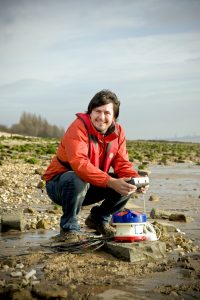During the EGU Election Autumn 2017, all EGU members are asked to give their vote for the next EGU Union President, General Secretary and the Division Presidents until 30 November 2017. The Geomorphology division is in the luxurious situation of having three candidates for division presidency, all of which gathered experience as active members of the EGU GM division structure.
In order to get to know the candidates a little better, the early career representatives of the GM division (Annegret Larsen and Micha Dietze) have asked the candidates a few questions from a ECS perspective. Below, we post the answers given by candidate #1, Dan Parsons.
Name: Dan Parsons
Webpage: http://www.hull.ac.uk/Faculties/staff-profiles/Professor-Daniel-Parsons.aspx
Twitter: @bedform
ECS: What is your field of research (three poitns maximum)
Dan Parsons: Geomorphology, Sediment transport, Morphodynamics
Why do you want to run for president?
I am thoroughly enjoying my time as a Division Science Officer within EGU and helping to set the objectives and direction of the GM and SSP divisions, and contributing to the shape of the EGU General Assembly each April over the past few years. I have also enjoyed being part of the ESurf team of associate editors – seeing the journal grow and evolve within the community has been very rewarding.
GM interfaces and interacts with almost all Divisions within EGU, with a high number of co-organized sessions across the general meeting being a visible outcome – this creates challenges but also significant opportunities. Sustaining the volume, breadth and quality of contributions to the GA within GM, taking advantage of other opportunities to bring people together in smaller meetings with leveraged EGU support (e.g. Galileo Meetings) – and thus confirming EGU in a position at the forefront of geomorphological science globally, is what I would like to ensure over the coming years as Division President. However, we need to also safeguard that the General Assembly does not become too bland and that smaller cutting-edge interdisciplinary areas are not lost in a growing meeting – retaining this distinctness is key and something I am passionate about.
Overall, I have benefited enormously from the networking opportunities EGU has created for me early in my career and I would like to serve, you the community, and give something back to the through my energy and leadership experience in the role of Division President.
What is the first thing you will change once elected president?
The Presidency of the GM division is an exciting challenge and is a position I would be honoured to serve. My aims in role would be to ensure that we continue to now evolve a new and open strategy around maintaining GM distinctiveness within broader EGU interactions, safeguarding a focus on serving Early Career Researchers and retain and build on an open and transparent leadership of the community.
In essence I feel that we need a strategy on what we want the GM division to look like in 5 years from now as EGU continues to evolve – and as such we need to decide as a community what actions we need to shape this strategy and direction.
This is something I would look to build and develop community consensus around in the role as President-elect so that we have a clearer decision base and response pathway. Additionally, and as part of developing this strategy I think there is a need to enhance our communications across the division. This has been much improved over the past few years, but we can do more. As such I would look to instil a more regular communication bulletin across GM and look to utilise a range of platforms, such as the use of notifications and social media, in delivering this enhanced communication.
What is your view on the role of early career scientists within the EGU GM division?
ECR’s are the engine of the division and EGU more generally. The General Assembly is, in my mind, to a large degree, an ECR meeting. As such the strategic direction of the General Assembly, the Division and the EGU more generally needs to be driven by the needs and desires of the ECR community. I am proud of the number of sessions organised and led by ECR’s within GM at the EGU GA – this is something I have championed in my Science Officer role over the past few years. The networking and profile building opportunities that the EGU GA offers is a valuable outcome of EGU as a whole. Embedding ECR’s and fora into the evolution of an enhanced GM strategy and decision base will be a key outcome should I be elected. We have made good advances in facilitating the building of an active, diverse and welcoming ECR community – one that we are rightly proud of as a broader community. We need to cherish and build on this to ensure that we have an environment that serves the ECR community and the symbiotic relationship between the ECR community and EGU as a whole thrives.
How will you safeguard diversity and inclusiveness within the EGU GM division?
Although great strides have been made, I think there needs to be enhanced openness around the issues of diversity and inclusivity at EGU and within the GM Division. Progress is best achieved through improved visibility of our gender and other diversity imbalances – and exposing such biases and discussing them openly is critical to making headway on such issues. This includes open discussion and enhanced communication, around the membership, of committees and award nomination statistics and the way in which we organise calls for positions and nominations, such that an improved balance, more in keeping with our membership’s diversity, can be achieved. This cannot be achieved overnight but the development of the enhanced strategy discussed above, which has these issues forefront within and embedded into the vision, are major steps to achieving parity across the division and EGU more generally.

